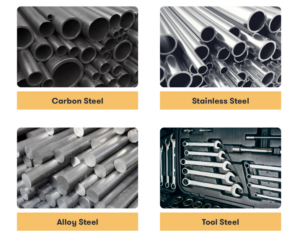Steel, which seems to be an ordinary material, actually contains endless possibilities. It is not only the foundation of modern industry but also an indispensable part of our lives. Today, we will delve into 4 common steels and their applications, allowing you to have a deeper understanding of this magical material.

Classification of Common Steels
Steel comes in different types, different categories, different shapes, and different sizes. While there are many ways to classify steel, here we divide it into four categories:
Each type of steel has its unique properties that determine its different uses.
According to AISI, steel can be divided into four basic categories based on its chemical composition:
- Carbon Steel
- Alloy Steel
- Stainless Steel
- Tool Steel
Different steels have different properties. All steels are composed of iron and carbon. The content of carbon and other alloying elements determines the performance of each type of steel.
Steel types can be classified based on various factors:
- Composition: Carbon range, alloys, stainless steel.
- Production method: Top pushing, electric furnace, etc.
- Fabrication methods: Cold rolling, hot rolling, cold finishing, etc.
- Form or shape: Rod, bar, tube, plate, sheet, structure, etc.
- Degassing process (oxygen removed during steel making): Killed and semi-killed steel, etc.
- Microstructure: Ferrite, pearlite, martensite, etc.
- Physical strength (based on ASTM standards).
- Heat treatment: Annealing, quenching, and tempering, etc.
- Quality classification: Commercial quality, engineering quality, pressure vessel quality, etc.
Numbering Systems for Steel
The steel industry mainly uses two numbering systems. The first one was developed by the American Iron and Steel Institute (AISI), and the second one was developed by the Society of Automotive Engineers (SAE). Both systems are based on four-digit codes for identifying basic carbon and alloy steels.
If the first digit in the name is a 1, it indicates carbon steel. In both the SAE and AISI systems, all carbon steels fall into this group, such as 1xxx. They are also divided into four categories based on their specific fundamental properties.
Common carbon steel is included in the 10xx series (with a maximum manganese content of 1.00%). The 11xx series contains carbon steel with re-sulfurization. The 12xx series contains carbon steel with re-sulfurization and re-phosphorization. The 15xx series contains high-manganese carbon steel with no re-sulfurization (with a maximum manganese content of 1.65%).
In the SAE-AISI system, the first digit classification for other alloy steels is as follows:
1 = nickel steel
2 = nickel-chromium steel
3 = molybdenum steel
4 = chromium steel
5 = chromium-vanadium steel
6 = tungsten-chromium steel
7 = nickel-chromium-molybdenum steel
8 = silicon-manganese steel and other various SAE grades
The second digit of the series indicates the concentration of the primary element in percentage points, but this may not always be the case. The last two digits of the series indicate a carbon content of 0.01%. For example, SAE 5130 is a chromium alloy steel containing approximately 1% chromium and approximately 0.30% carbon.
Carbon Steel:
Carbon steel can be divided into three major categories: low-carbon steel, medium-carbon steel, and high-carbon steel.
Low-carbon Steel:
Typically contains 0.04% to 0.30% carbon. It comes in various shapes and, depending on the desired characteristics, other elements can be added.
Medium-carbon Steel:
Typically has a carbon content of 0.31% to 0.60% and a manganese content of 0.060% to 1.65%. Medium-carbon steel is stronger than low-carbon steel and is more difficult to form, weld, and cut. Medium-carbon steel is often used in heat treatment for quenching and tempering.
High-carbon Steel:
Often referred to as “carbon tool steel,” it typically has a carbon content of 0.61% to 1.50%. High-carbon steel is difficult to cut, bend, and weld. After heat treatment, it becomes extremely hard but also brittle.
Why Choose Sino Stainless Steel?
Thank you for reading our article and we hope it can help you know 4 common steels and their applications better. If you want to find more information about stainless steel, we’d advise you to visit Sino Stainless Steel.
As a leading supplier of stainless steel products across the world, Sino Stainless Steel provides customers with high-quality stainless steel products such as Hot-rolled Stainless Coils, Cold-rolled Stainless Steel Coils, Polished Stainless Steel Coils, Stainless Steel Wires, Stainless Steel Tubes, and Precision Stainless Steel Sheets at a very competitive price.
 :+86-13012867759
:+86-13012867759  :export86@sino-stainless-steel.com
:export86@sino-stainless-steel.com
She did not know of any connection between Tamox and Benedryl how to buy priligy in usa